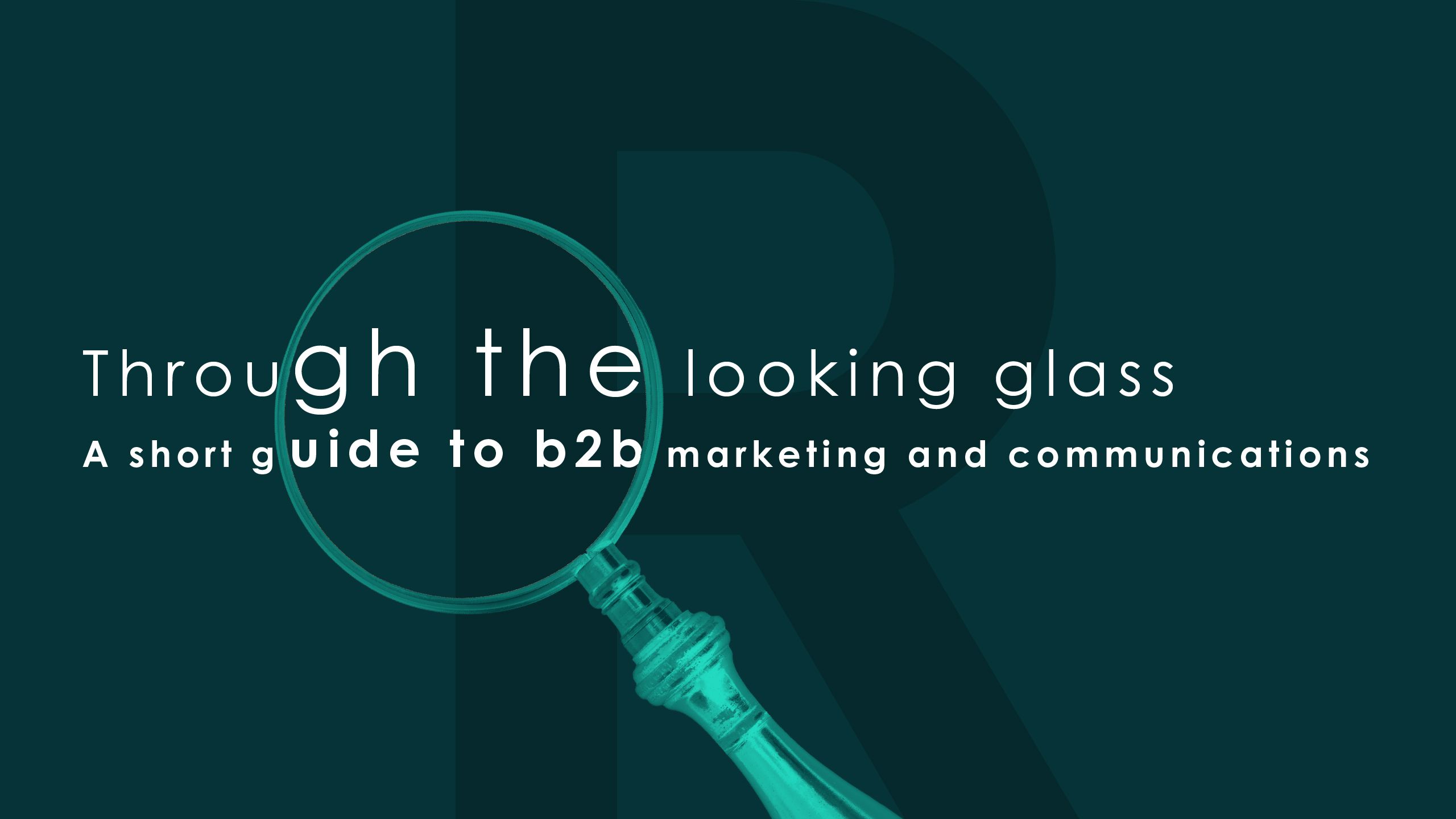
The world of b2b content and marketing is continually evolving. It’s a dynamic market which requires a thoughtful, insight-led approach to cut through with b2b buyers.
“B2B is often viewed as a complex, specialist and challenging field. But good b2b communications can be every bit as simple and straightforward as the best consumer campaigns. In the world of b2b, for brands and marketers, the challenge is how to tell the stories that matter. It’s about creating positive, lasting impacts with your target audiences and influencing their buying behaviours.
“As a Top 5 b2b agency operating in the UK market and globally, Rostrum has created this short guide with the aim of sparking ideas and creating better conversations among b2b marketers. We hope it’s a useful starting point for those planning new campaigns and initiatives in b2b. The Rostrum team is always available to speak to b2b marketers seeking ideas and inspiration. Contact us on b2b@rostrum.agency."
Mark Houlding, CEO, Rostrum

Storytelling is a feature of all cultures across all eras in every part of the world. Telling stories is fundamental to our identity as human beings, underpinning social cooperation and teaching social norms. Storytellers are valued members of human society. Skilled storytellers — think of novelists and artists, actors and stand-up comics — are attributed a high social status.
Storytelling is at the heart of b2b marketing and communications. Creating powerful, engaging brand stories enables b2b brands to trigger the emotional responses that drive conscious and unconscious decision-making. Good b2b storytelling takes the audience on a journey, creates tension and ends in resolution. It brings content to life, establishes the rules of engagement for buyer and seller and it enables brands to demonstrate value rather than telling their audience about how valuable they are.

The world of b2b is divided into sectors – from mortgages and real estate to oil and gas, tech and telecoms. Each b2b sector has its own dialect, tropes and quirks – as well as a broad suite of media and content which tells the stories of the particular market. Knowing what content works in a specific market segment and understanding the rhythms and cadences of the annual cycle of that sector is key. Editorial calendars and content marketing plans should encompass industry events, regulatory milestones and key publishing dates – while also remaining flexible and responsive. Speaking the language of the market you’re trying to reach is vital in terms of landing your message and making a positive difference to perceptions of your brand.

Too much b2b content is planned and created from an ‘inside out’ perspective – starting with the firm’s capabilities and strengths rather than starting with what customers might actually want to hear about and engage with. Knowing your customer is a central element of b2b success. The b2b buyer is constantly evolving, changing, consuming – and unlike ‘all the little Oysters’ they don’t stand still. Internal silos and structures too often don’t reflect changing customer demands and complex b2b markets. For example, ‘financial services’ is a huge industry including insurance, wealth management, banking, fintechs and more.
Many brands producing b2b content focus on the C-suite but influence now resides across the value chain. Don’t overlook the role of managers and executives in influencing and shaping director-level decision-making. B2B buyers also consume content from a broad range of sources so continual testing and learning is advisable. Starting with a customer-first strategy – figuring out what your target customer looks like – who they are, what drives them, what content they consume and so on – ensures your messages and content have a better chance of resonating with them.
Social media enables you to accurately locate b2b buyers at all levels, and to understand what types of content tend to engage their interest. At Rostrum, we call this ‘social listening’ and we see it as the intersection between PR/comms/social strategy and account based marketing.
We’re big fans of the social listening process – it removes a good chunk of the assumptions and intuition that often informs campaign planning and it delivers real value for client marketing and business development teams.

Strategy informs action in b2b. Campaign planning often starts with the desire to produce in a particular channel before refining the strategy and the message (‘let’s do a podcast!’) but this rarely delivers the desired results. Time spent thinking, planning and refining the message and the approach will pay dividends at the point of going to market. It’s always worth asking ‘why’ before moving to ‘how’.
When it comes to selling-in, get a good media relations expert from your team to check the core message and headlines you want to land with your content – if they don’t feel confident picking up the phone to a journalist to pitch the story, more work needs to be done.

Journalists are people too. Investing in your relationships with the media means your stories will be given a hearing and enable you to keep your finger on the pulse of the market. Industry writers migrate to the nationals and take their sector contacts with them.
‘Off the record’ is one of the most important ways you can build relationships with journalists – think about whether you can be a useful source as well as a quoted expert. And if you’re being quoted, give a good quote! ‘Sound and fury, signifying nothing’ doesn’t help journalists to make their argument persuasively.
It’s also about time. If you’re not quoted the first time you meet a reporter, don’t panic. Introductory briefings rarely lead directly to coverage – remember that journalists build up their contact books over a number of years. To do it right you need to invest in those relationships over time. And don’t forget freelancers as they have huge value to add too and can often work with you to really craft a story.

Good b2b content marketing takes time to plan and deliver. Spend time thinking about what you are saying and why it’s the right topic for you to be focusing on, as well as the right time to say it. Consider how your message is going to land, how you’ll stay relevant as a conversation evolves and undertake scenario planning for how it’s going to play out across multiple channels.
Data continues to drive decision-making in b2b and where content is forward-looking, insightful and backed up by credible data, engagement rates soar. Creative campaigns still very much resonate with b2b buyers but the world of b2b is moving to a more responsive, nimble publishing model, less focused on making a huge splash with set-piece thought leadership reports
published annually.
New digital publishing tools provide great opportunities to move away from content creation using PDFs (a content sharing technology developed in 1993!) to more engaging, measurable formats. Shorthand (which you’re reading now) is one way we do this at Rostrum. It’s a creative way to deliver corporate storytelling and corporate content in a digital, interactive, engaging and measurable medium.

Influencer marketing is growing in importance within the b2b marketing channel, but it can be a challenging discipline to get right. Operating in the margins between paid, owned and earned media, it demands a genuine partnership and authentic content in order to reach its full potential.
Working out your strategy, how you’re planning to measure success, timings, tone of voice, content strategy and messaging are all vital before you even start thinking about who you might like to invite to partner with you on your campaign.
B2B influencers can offer brands a uniquely authentic route to market, unlocking new audiences and buying opportunities. But distinguishing the influencers who can add real, measurable value to your brand and drive business development goals versus those who will generate a lot of likes and clicks but not much more is a key challenge to overcome – and one that should be addressed before you start.

In b2b communications, strive to avoid jargon and clichés. Don’t try to blind your audience with the science. The average reading age in the UK is 9 years old and the average attention span for focussing on a single task - like reading an article - is between 10 and 20 minutes. Keep your communications clear, impactful and simple to seize and hold attention. This doesn’t mean dumbing down, but it does mean being committed to clear and effective communication. Be ruthless when eliminating acronyms, misplaced capitalisations and clichés. This goes for all of your b2b content, but especially any quotes you write. When ghostwriting quotes for someone, it helps to imagine them saying the words (read it “aloud in your head”). If what you hear doesn’t sound like something a human being might say, you need to change it or your copy will sound clunky and inauthentic.

Thought leadership is the bedrock of many effective b2b content marketing programmes. Well-planned, strategic thought leadership can define the debate in a sector, reshape b2b buyers’ thinking and set the agenda for the months and years to come.
Effective thought leadership finds the white space, offers a new angle on an existing debate or highlights changing trends and patterns. At its best it’s forward-looking in nature but the data and insights which underpin the work are often informed by past events. Good thought leadership challenges and cuts through, produces statistics that become requoted and shared by decision-makers and business influencers, and finds its way into the public discourse in a positive, meaningful way.

Begin with the ambition of measuring everything. Agree metrics for your campaign, stick to them and use them as the basis for reporting. Every campaign is different. Start with the confidence that your work is measurable and if done right will have an impact on your brand and revenues. If you don’t do this from the start you won’t be able to go back and measure it retrospectively.
There is only so much ground we could cover in this short guide to b2b marketing and communications. If you’d like to have a more in-depth conversation about your requirements, if you have a brief you’d like to discuss or a story to share, we’d love to hear from you. Please get in touch with us on b2b@rostrum.agency.
*All quotes Lewis Carroll, Alice in Wonderland

